Today's blog is an excerpt from my book on Metal Dolls. I hope you enjoy it. I am still looking for clear photographs for this book, and you can email me at etsag1998@aol.com with photos and questions. eBay photos work nicely and are easy to mail. Also, include how you would like to be credited. Two sites I recommend for doll and toy enthusiasts are The Official Louvre Website and the Musee de la Poupee. There are links and activities for children and adults, and excellent displays in both on dolls. Each has a museum store, of course. The Louvre is easy to search; I put in the word "doll" and found all kinds of beautiful examples of painting and art but also example of Ancient Greek and Roman dolls, some articulated. It is easy to print and download these photos, and The Louvre is generous with printing and dowloading rights. The first time I saw these ancient playthings in the National Museum in Athens, and I cried. I had seen photos in my friend Mary's book, but these were just amazing in person. I cried to think of those little girls so long ago who must have loved them, and I cried because they were so beautiful and survived so much. Forgive me for not having figured out accents for the French words; I'm getting there. Also, I'm still not clear about including actual links, so for now, I will give titles and keywords of museums and websites that may be Googled. Enjoy the reading.
Chapter Five
Dolls With Metal Heads from Germany, America and Belgium
and France
The first metal dolls were manufactured in France and Germany. Heads, legs and hands were made of copper, zinc, brass, lead, tin, pewter or aluminum. metal dolls were made from 1860 to 1870.
Betty O. Bennett
Collectible Dolls: Facts and
Trivia. Volume One.
While the beautiful mechanical dolls discussed in the last two chapters often had heads made of delicate bisque, other dolls that did not move still had heads and/or bodies of metal. Dolls with metal heads have existed for a long time, but did not enjoy any popularity till the end of the nineteenth century. The three most famous trademarks were Juno, Minerva, and Diana. Karl Standfuss of Deuben bei Dresden made the Juno heads, which bear the crown mark. As early as 1880, German metal headed dolls may have appeared, though other collectors say that they were mass-produced in Germany by 1894 (Fawcett 213). Then, beginning in 1900, Standfuss made metal and celluloid dolls, heads and parts. One of the advantages of metal headed dolls was that one could push them back into shape if they were dented. Of course, doing so left chipped paint and other imperfections. Metal used for heads in the 1890's included brass, zinc and tin plate. The heads were mainly mass-produced in Germany. Those made in 1894 often had sawdust-filled bodies, glass or painted eyes, and natural or molded hair. Some fancy hairstyle metal heads appeared when elaborate bisque heads, the so-called "parian" dolls, were popular. Two of these dolls date from the 1870's and are made of pewter. They are from the late Gladys Hyls Hilsdorf collection and are considered quite rare. The heads have flowers molded into them and are set on wooden bodies.
Besides the Juno heads, there were many Minerva metal heads made at the end of the century. These heads, made by the firm of Buschow and Beck were made in Germany and sold in the United States through A. Vischer and Co., New York, NY. Several German heads, including some Minervas, were exhibited at the St. Louis Exhibition of 1904. Minerva dolls were advertised under different brand names, one of which was the "Wearwell Brand." This doll usually had a four-inch metal head with fixed, blue glass eyes. The head was marked "Minerva" across the front and "Germany/3" across the back. Sears Roebuck advertised these dolls in their toy catalog. AT one time, Minerva heads were so popular, that one Butler Brothers catalog equals the Minerva doll to the Kestner bisques, saying that "the Minerva doll enjoys a reputation equal to the Kestner brand of dolls." (Angione 167). Also during this time, Minerva heads were more expensive than bisque heads. For example, Minerva heads sold for $4.25 per dozen, while comparable bisque heads sold for $2.25 per dozen.
Furthermore, a 1903 Montgomery Wards catalog advertised Minerva heads from $.25 for a head of 2 5/8 inches to $.75 for a four-inch head. A four inch head was for sale for $45.00 at a recent doll show, held November 10, 1996 in Davenport, IA. The head had painted features and hair, and was in fair to good condition. Dolls with the added features of teeth and glass eyes sold for $.75 each to $1.75 for a head of 5 3/8 inches. Curly-haired doll heads cost $.50 to $.75 each. The same catalog advertised Minerva "Knockabout" dolls. These dolls were eleven inches long with silesia bodies and came without wigs. Janet Johl, in one of her books, describes an unusual Minerva with a wig, glass eyes and four "china teeth." (Johl SMAD 114). Another collector told Johl of a doll "either Minerva or Juno" marked "Made in Germany/D.R. Patent and England Pat./D.R.G.M." (Johl 114). "D.R.G.M." means "patent applied for." This doll was thirteen and one-half inches tall with molded/painted hair and a blue sateen dress which fit over a metal platform supported by four wheels. When activated, the doll turned around and around. A similar French doll that stands about 18 inches, with bisque head, glass eyes and teeth, and a long, metal skirt that covers a wheeled platform cost approximately $3000 at a doll show in Davenport, IA, November 10, 1996.
In 1912, Minerva advertised a doll that shed real tears. The author, however, has never seen one. Genevieve Angione shows and discusses in her book All Dolls are Collectible a boy marked with the Minerva mark. The head is six and three-fourths inches in circumference with a number "three" embossed on the back. The eyes are painted blue and have white highlights and red dots at the corners and nostrils. The ears are molded and slightly detached. The hair is brown, the body stuffed with hair. The boy's hands are chubby and bisque.
Currently, metal headed dolls bring a variety of prices. The author has seen a badly rusted and corroded, four-inch head without the inset eyes for $68.00. A three-inch example of the same type of head, but with fair condition cost $20.00 in 1988. Entire dolls bring anywhere between $28.00 and $400.00 in very good condition. For example, a sixteen-inch metal head on a cloth or kid body with bisque or composition hands, dressed and in very good condition sells for $135.00 (Foulke 288). Most complete dolls seem to be priced in the $75.00 - $125.00 range. A mint doll, fourteen and one-half inches high, with inset blue glass eyes, original wig and kid body was advertised in a 1988 issue of Doll Reader for $225.00. A similar, thirty-inch Minerva example sold for $300.00. One cannot help but compare these prices to the original ones. For example the Minerva "Little Rosebud" advertising doll cost $.25 with several sales of subscriptions of the Youth's Companion in 1911. With the doll came a set of paper patterns for outfits like middy suit, tam o'shanter and French dress. After selling more subscriptions, one could get a folding basket and dressing set which included among other things, a comb, powder box, mirror and toothbrush (Simonelli 46).
Of course, other companies besides Minerva were making metal dolls at various times. One twenty-three inch doll with a metal shoulder head has a wig, open mouth and sleeping eyes. The doll is marked "Germany 15." A similar doll with a closed mouth and no marks is thirteen-inches high (Schroeder 88). A metal headed boy has no marks and painted features. His body is cloth with bisque arms and leather legs. An R. H. Macy catalog of the early 1900's describes a "Diana" metal head as unbreakable with moving eyes and a wig. The head came in eight sizes and cost between $.44 and $1.39 (Simonelli 46). The Diana head is rare. According to Johl, a constant supply of metal heads for Europe was replacing fancy bisques and china heads (151).
American companies, too, made metal heads. The Metal Doll Company, which was run by Vincent Lake, made an all-metal jointed doll with interchangeable wigs. Lake was an inventor from Pleasantville, New Jersey. In 1899, he had patented a new typographic machine and had great hopes for his new invention. According to Miriam Formanek-Brunell in Made to Play House: Dolls and the Commercialization of American Girlhood 1830-1930, Lake's excitement was short lived. The Linotype came along and rendered his brainchild obsolete (35). Apparently disappointed and jaded by what Formanek-Brunell calls "the masculine world of printing," Lake invented the all steel doll, complete with steel springs. Formanek-Burnell, whose book places a feminist slant on the doll manufacturing industry, calls the doll the "epitome of the American male world of business and production from which he came" (36). In fact, Formanek-Burnell observes that by the turn of the century, "men with origins as diverse as carriage manufacturers and typesetters would end up as doll manufacturer," placing their knowledge of making everything from pulley-belts and carriages to clocks and various machines to use in making dolls (36). In fact, many companies at this time were involved in the mass production of dolls and toys, and many of these were made of metal.
The Metal Stamping company made walking metal figures of various kinds. An old soldier in the author's collection is similar to these. He stands eleven-inches high and is all metal. His arms are jointed, when key-wound, he plays a metal drum. Though badly rusted, the doll's painted features are still visible. A smaller example of the same doll stands seven-inches high. Metal Frozen Charlotte type dolls regularly appeared in Crackerjack boxes as prizes. One such doll in the author's collection is attached to a baby announcement card along with a metal stork. It dates from the 1880's. A very unusual, all metal baby doll was made by the Atlas Doll Co., between 1917-30. Heads from this company are generally unmarked. Atlas had its location in Baltimore, MD and produced about sixty-five types of dolls in 1921. The baby doll was modelled after the bent-legged bisque headed babies of the era. According to Lauren Jaeger in "Identifying Your Dolls," Doll World, Oct. 1993, Atlas and other American companies entered the doll marked during World War I to fill a need for dolls (12). Ms. Jaeger values an Atlas baby doll at $50.00 (12). Other unusual metal dolls represented young girls or baby. At the Lasalle-Peru doll show, held October 13, 1996, the author saw three interesting heads at the following prices. A girl's head, six-inches high, with blue sleep eyes and painted, "flapper" type black hair in fair condition was $45.00. Baby or toddler's head, no wig, with sleep eyes, fair condition , was also $45.00. A complete baby doll, about 18 inches high, with sleep eyes and old clothing, in good to fair condition cost $110.00.
The author has a metal girl in her collection that is about seventeen-inches high. The doll's body is cloth, her limbs composition. The hair is molded in a bob style with a molded
loop for a ribbon. The original dress is of a taffeta, the print faded to a lavender color. The paint and features are in good shape, though the doll was a good price at $75.00. Dolls of this type are usually valued at $200.00 or more.
Perhaps the most famous American metal head, however, is the Giebeler Falk doll by the Giebeler Falk Doll Company of New York. In 1919, the company took a patent, No. 18,550, for making dolls, outfits and parts. One of the marks on the dolls is "Gie-Fa" with the Star of David. The doll may also be marked with "G" inside a Star of David with "U.S. Pat." underneath. The doll came in sixteen, eighteen, twenty, twenty-two and twenty-five-inch sizes. These heads are made of heavy gauge aluminum and appeared during the latter years of World War I. They had sleeping eyes of metal attached tot he head with five washers. A nut and bolt secured these to adjust the swing of the eye weight. The hands, feet and head were coated with baked-on enamel and the body was of lathe-turned wood and fully-jointed. In the author's opinion, these are among the loveliest of the metal heads and closely resemble the bisque heads of the era. The author is lucky enough to have a
Giebeler-Falk head in her collection, though the wig, body and dress are replacements. In 1919, Gibeler also make a phonograph doll. The doll's crown was hinged and inside was the horn and turntable for the phonograph. The mechanism was in the doll's body and the crank was in the back.
Subscribe to:
Post Comments (Atom)
























































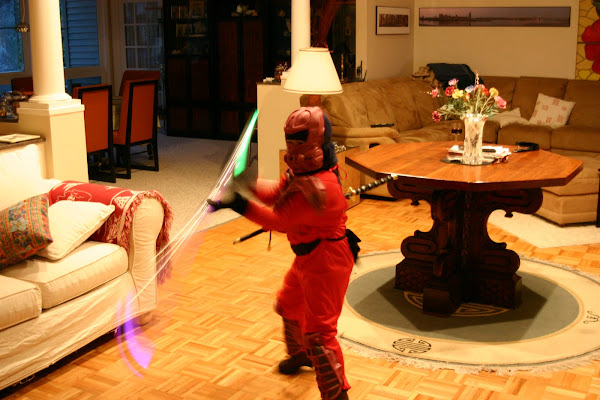

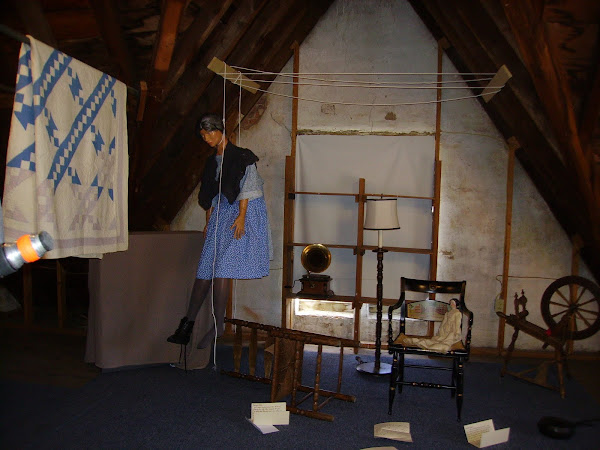
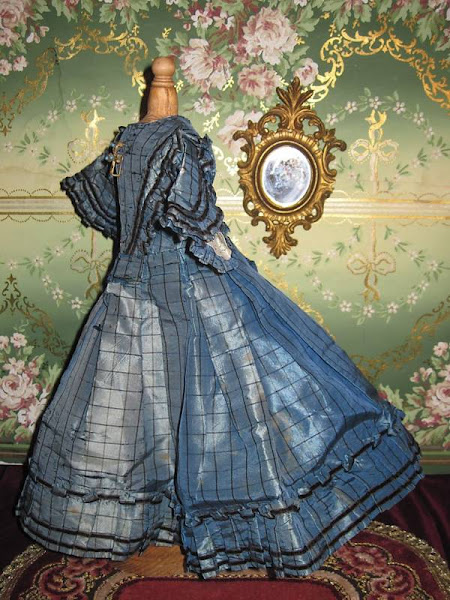wCWk~%24(KGrHqV,!h8Ew5GsnS3dBMUy3MzVPg~~_3.jpg)


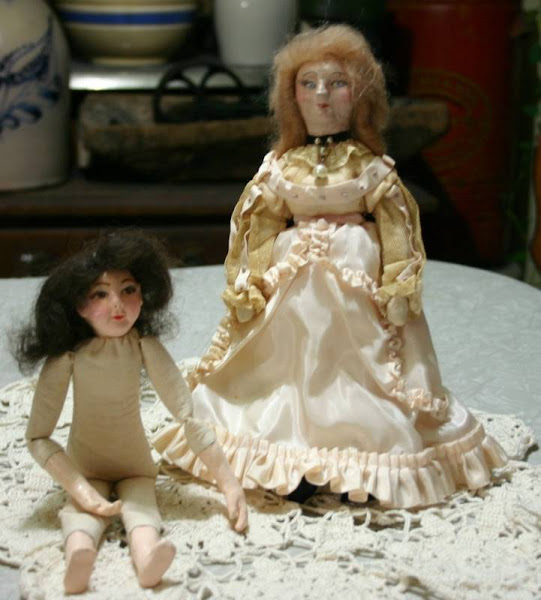









































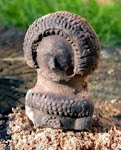
















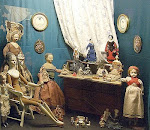



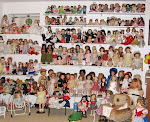
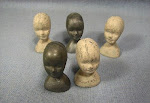



No comments:
Post a Comment